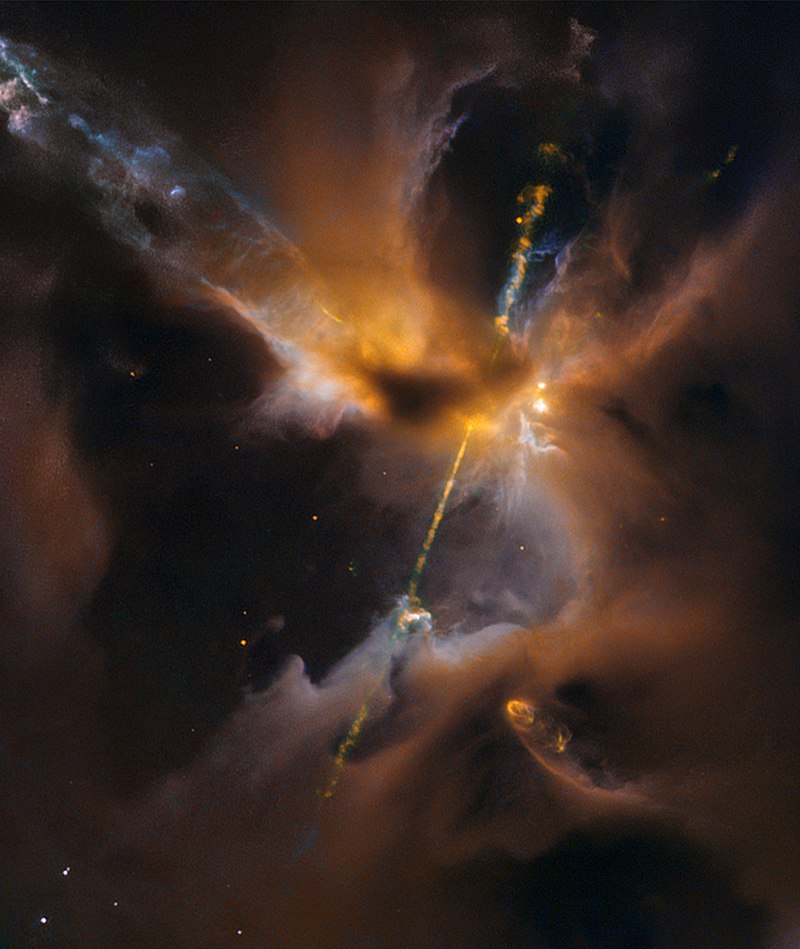When we look at images of star birth regions, they look both placid and active at the same time. That’s nowhere more true than in a stellar nursery associated with a so-called “Herbig-Haro” object. A recent image from Hubble Space Telescope zeroed in on two called “HH 1” and “HH 2”. It looked at the turbulence associated with a nearby newborn star system.
These two glowing clouds of gas and dust lie about 1,250 light-years from us. They’re in the direction of the constellation Orion. HH 2 is at the bottom left (in blue) and HH 1 is at the upper right. It’s near a bright star that isn’t actually part of the action. You can’t see it, but the star that’s actually making them glow lies between them. It’s hidden by a thick cloud of gas and dust. However, we know it’s there because it’s sending a jet of material out. That’s what’s brightening up the two HH objects. This is not the first look at these clouds by HST. In 2002, it revealed that parts of HH 1 and its related stellar nursery are moving at more than 400 kilometers (248 miles) per second!
Hubble’s View of a Stellar Nursery
Hubble’s Wide Field Camera 3 captured the latest view of the turbulent stellar nursery. Instead of looking at it solely in visible light (what astronomers call “optical”) the camera used 11 different filters at infrared, visible, and ultraviolet wavelengths. Each of these filters is sensitive to just a small slice of the electromagnetic spectrum. They allow astronomers to pinpoint interesting processes that emit light at specific wavelengths.
In the case of HH 1 and 2, two groups of astronomers requested Hubble observations for two different studies. The first delved into the structure and motion of the Herbig-Haro objects HST studied. That’s giving astronomers a better understanding of physical processes at work when outflows from a stellar nursery collide with surrounding gas and dust. The second study investigated the outflows themselves. The idea is to lay the groundwork for future observations with the NASA/ESA/CSA James Webb Space Telescope. JWST can peer past the clouds of dust enveloping young stars, which will revolutionize the study of their outflows.
A Very Brief History of Herbig-Haro Object Studies
Astronomers first observed these wispy clouds in the late 1880s but didn’t recognize them as emission nebulae until the early 1940s. Essentially they get “lit up” by light from other objects. That causes them to glow and emit light themselves.
Astronomers George Herbig and Guillermo Haro studied these glowing clouds in the late 1940s as part of research into stellar nurseries. Today, after observations of other similar HH objects, astronomers understand them as shock-induced phenomena driven by jets from nearby protostars. There are more than a thousand known individual HH objects, and they’re usually (but not always) found near Bok globules. These are cold, thick clouds where protostars begin their journey to full star status.

What we’re really seeing in an HH object is a snapshot in time during the life of a star. Most of the newborn stars that emit jets could be anywhere from tens of thousands of years to just under a million years old. They’ve started nuclear fusion, but are still collecting gas and dust during accretion. Their jets move out at very high speeds and collide with clumps of gas and dust, causing them to glow. Many of the HH objects have two or more stars, which may explain the formation of some of the jets. Such regions remain favorite targets for the Hubble Space Telescope, as well as the infrared-sensitive James Webb Space Telescope.
For More Information
Hubble Views a Turbulent Stellar Nursery
The Birth of Stars: Herbig-Haro Jets, Accretion, and Protoplanetary Disks
The post Hubble Looks at Newly Forming Stars in a Stellar Nursery appeared first on Universe Today.
No comments:
Post a Comment